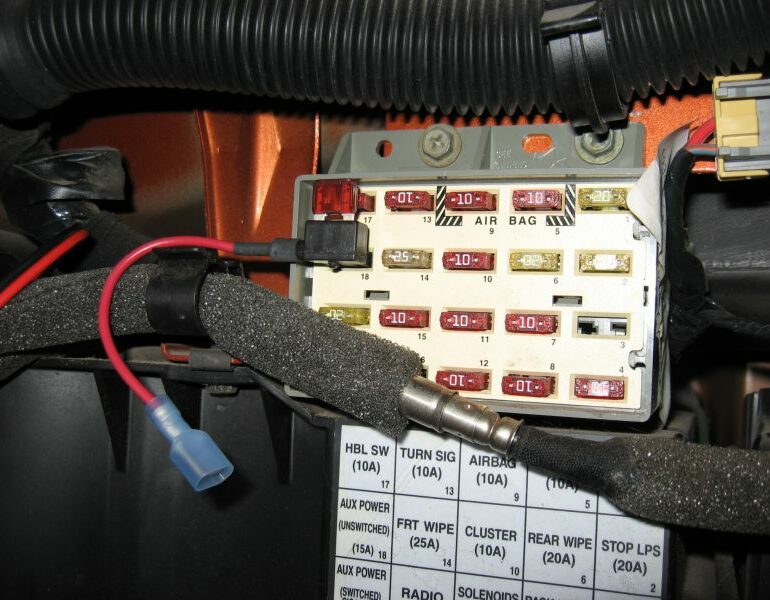After finishing the odds and ends associated with my Uniden Off-Road CB Kit review, I told the folks at Right Channel Radios CB Radio and Antenna Shop that if they wanted any other products reviewed, they could give me a shout and we could discuss what and when. I think a week went by and I received another e-mail from their sales manager asking me if I would be willing to review their Cobra Off-Road CB Kit.
I agreed to do the review as long as I didn’t have to install the kit in my TJ. The kit would contain the 3-way antenna mount and I honestly didn’t need another antenna mount (nor the associated mounting holes) on my TJ. RCR agreed to my suggestion that I find a CB-less TJ in the Phoenix area that could use the Cobra Off-Road CB Kit. We agreed that I would help with the installation (along with the TJ’s owner) and I would do the product review. The kit was shipped the following day.
Now….the only thing that remained was to find a recipient for the Cobra kit. Most (all?) of the folks I routinely wheel with have a CB in their Jeep so that list wasn’t going to get me anywhere quick. A friend of mine, Bob, had recently lifted his ’01 TJ and had ran a few trails. I got in touch with him and discovered that he was indeed looking to put a CB in his rig. He had been looking at the Cobra 75 the previous week and so was delighted to hear that the off-road kit I was providing was in fact the same radio. We agreed to meet within a few days and get it installed.
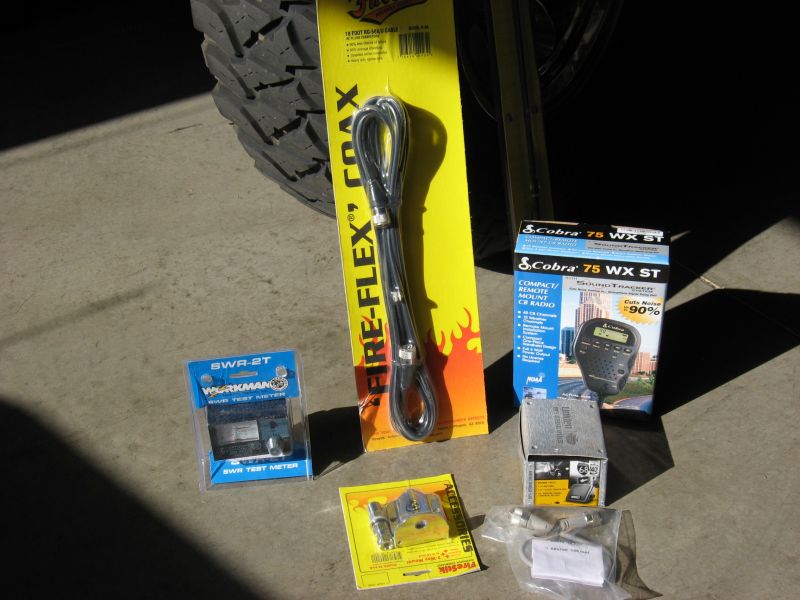
Similar to the Uniden Off-Road CB Kit, the Cobra kit comes with everything you need to get yourself up and running. Along with the Cobra radio came the 3-way antenna mount (as previously mentioned), SWR meter and patch cable, a 4′ Wilson Flex, Fire-Stik coax cable, and an external speaker. As with the Uniden kit, you can choose from three different antenna mounting solutions. I had previously told RCR that if they were bundling a kit with the Cobra 75, they needed to included an external speaker. While the radio works well in an enclosed vehicle, running a Jeep down the highway with half doors and big tires makes for a lot of background noise. The small speaker in the Cobra 75 isn’t up to the task. (This is a common complaint found in the on-line Jeep forums.) I was very happy to see they had remembered our discussion and included the speaker. It means one less trip to the local Radio Shack or truck stop to find a suitable external speaker once the installation is done.
Since the off-road kit is comprised of several components, I’ve done write-ups for each part of the kit. This will hopefully make it easier to find exactly what you need or if you are new to the CB game, just start at the beginning and work your way through to the end.
FireStik 3-Way Antenna Mount Installation
Right Channel Radios carries a large selection of Firestik products, and offers three different Firestik mounting options with the Cobra Jeep Kit.
This mount, made by FireStik, is primarily designed to attach to the large mirrors found on 18 wheelers. That being said, it will also support a 5′ tall antenna on a flat vertical surface. Tire carriers and bumpers are two places commonly used for mounting antennas. While Bob’s TJ is slated for a new bumper later this year, he wanted to try what was there so we decided to place the mount on his off-road bumper.
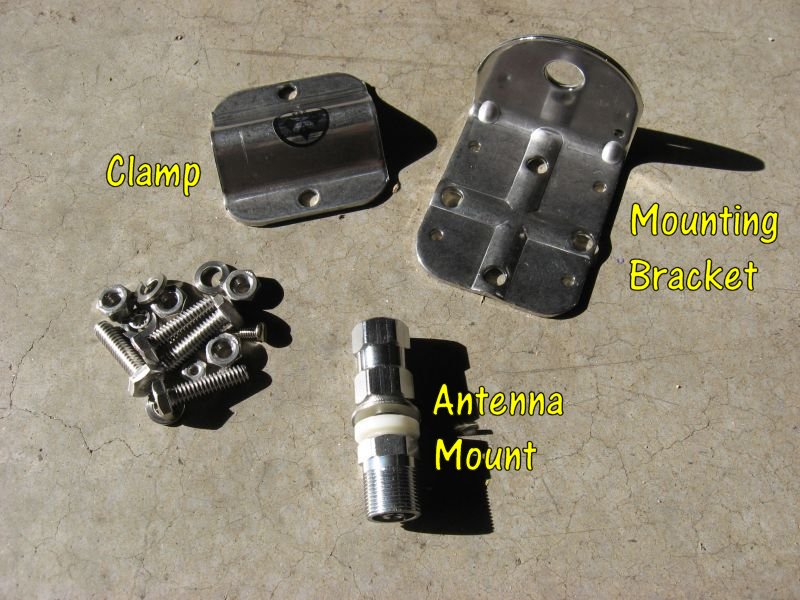
Right Channel Radio uses the higher quality stainless steel (FireStik offers this in chromed too) version of this mount. Since Bob’s TJ doesn’t have any big trucker mirrors, the clamp was not needed. The mounting bracket and antenna mount would be attached to the bumper.
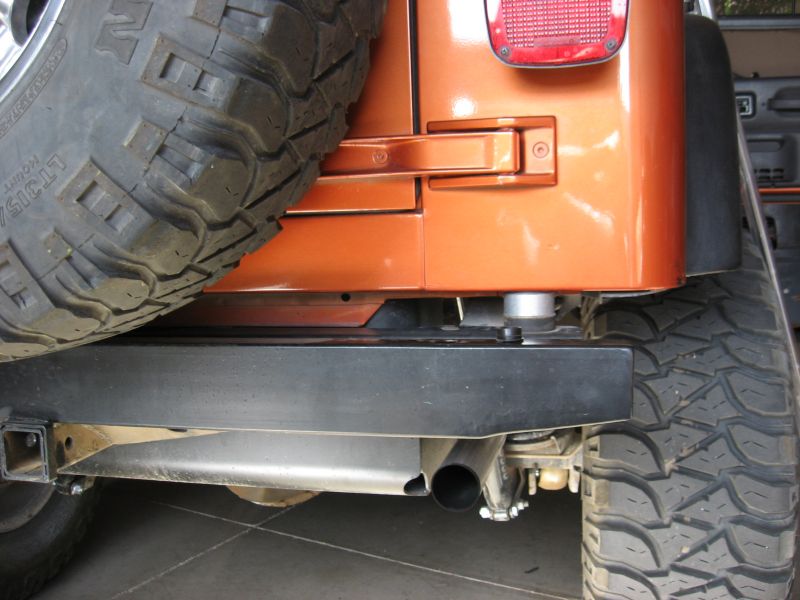
I’ll mention this just as I did with Bob before drilling the mounting holes. Locating the mounting bracket in this area (on the bumper) places quite a bit of the antenna close to the Jeep’s metal tail gate. This usually will cause antenna adjustment issues (which it did) as the antenna does not like being that close to the metal body. Bob intends to relocate the mount, higher up, when his new bumper/tire carrier is installed later this year.
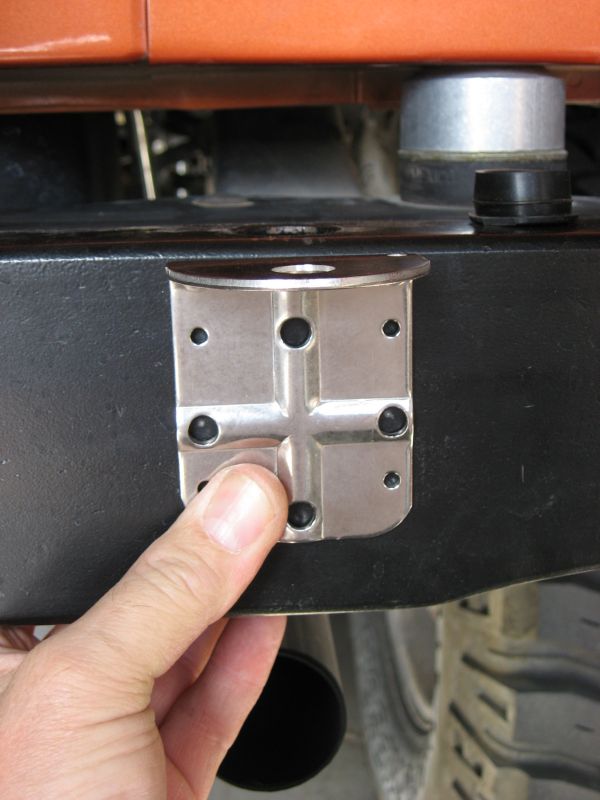
Locating the mounting bracket closer to the end of the bumper will provide you with more tail gate swing radius. (locating it up on the tire carrier gets it entirely out of the way) Using the mounting bracket as a template, I marked two spots where the 1/4″ holes would be drilled.

Since this particular bumper design is enclosed on all 4 sides, we selected the mounting spot adjacent to a hole (you would have to ask Bob why it was there) in order to avoid self tapping screws. I wrapped a piece of shipping tape (sticky side out) around my finger to use as a “hold the hardware in place while I put my finger through the hole” kind of tool. It worked nicely….the lock washers and nuts were all installed without dropping any of them into the bumper’s interior.
FireStik 3-Way Antenna Mount Installation

Next it was time to install the FireStik antenna mount in the bracket. This mount has the SO-239 RF connector built into the bottom of the antenna stud. The stud is placed through the hole in the mounting bracket and the remaining components are stacked onto the stud (shoulder washer, flat washer, lock washer) before the coupling nut is tightened in place. It is important to assemble the antenna mount in the order indicated.
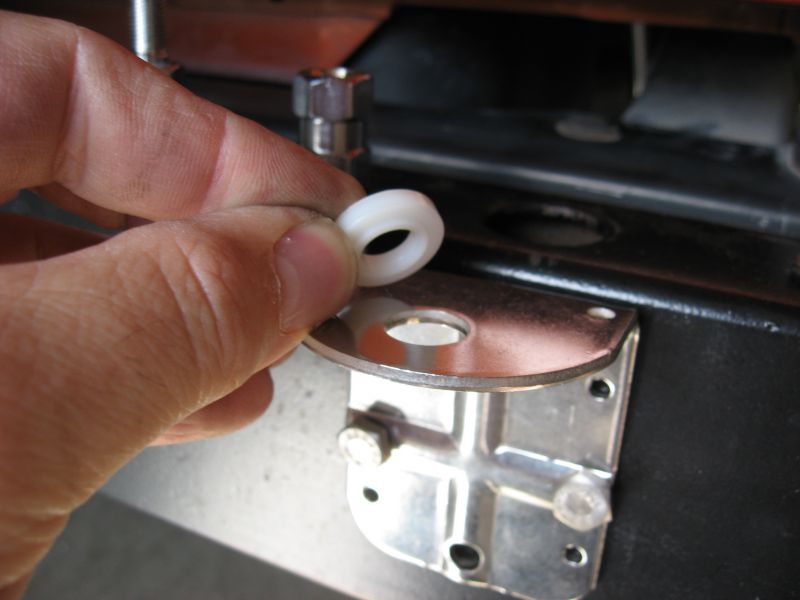
The shoulder washer has a ridge around it that must be positioned downward and into the hole in the mounting bracket. This properly positions and insulates the “RF hot” portion of the antenna from the grounded antenna mounting bracket.

Here is the mounting bracket with the antenna mount properly assembled (but not yet tightened). Again, be sure the small ridge, the “shoulder”, on the white insulated shoulder washer is placed ridge down into the hole on the bracket. I have troubleshot many antenna mount problems and the majority of them were the result of the installer not assembling the mount in the proper manner.
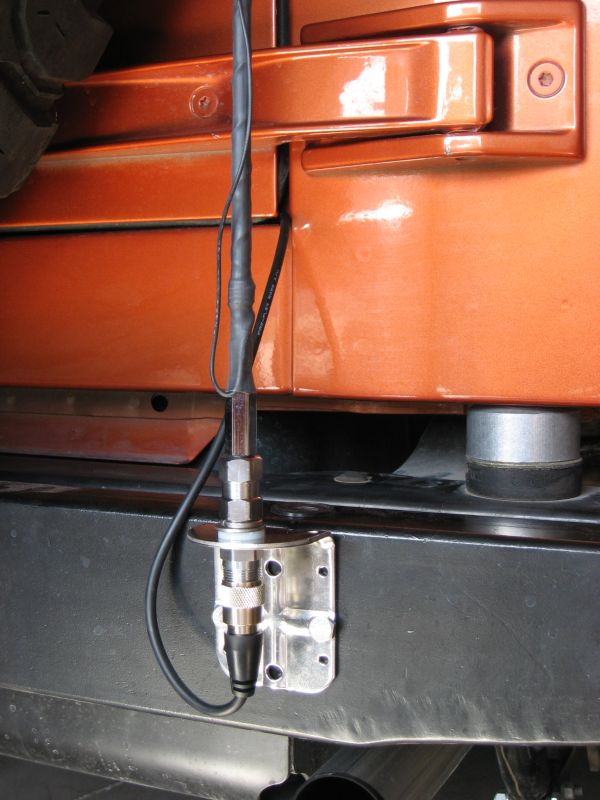
With the antenna stud tightened, we installed the Wilson Flex antenna into the top of the coupling nut and snugged everything tight. One end of the the FireStik coax cable was attached to the SO-239 RF connector on the mount. We checked for proper clearance between the tail gate’s weather gasket and the body and there was sufficient room, right at the corner, to run the cable into the Jeep’s interior. You NEVER want to crush or deform the coax cable. Doing so will cause an increase in the SWR and poor (no?) performance in the radio. Also, never route the cable under the bottom of the bumper….doing so will most certainly allow it to be cut in two should the bumper come down on a rock with the cable between it and the rock.
Let me also mention here that the selected location for the mount puts it in harms way, to some degree. It is possible that Bob might back the TJ’s bumper in to a rock and thus flatten (destroy) the antenna mount. It is also possible that he might slide off of a ledge and scrape the mount off the face of the bumper. He is fully aware of this and doesn’t anticipate running trails where this will occur, at least for now. As I mentioned earlier, this is somewhat of a temporary installation until the new bumper/tire carrier combo unit is installed and the antenna/mount is transfered to it.
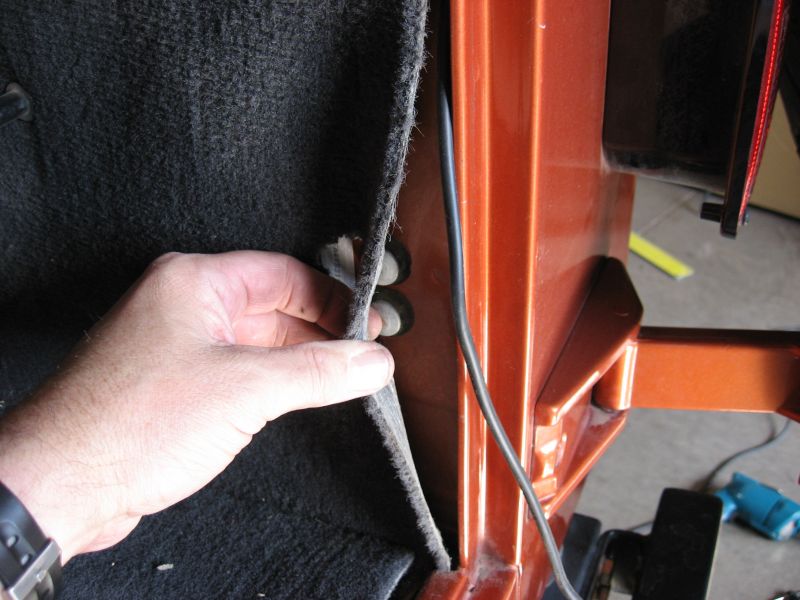
With the coax cable now inside the TJ, we routed the coax up and over the fender well area (beneath the carpet). This allow for a “snag free” cable path and kept it out of reach of Bob’s kids who routinely inhabit the TJ’s back seat. Kids being kids, snagging, stepping on, squishing, etc. the coax cable is NOT a good thing. The path chosen for the coax will do a good job of keeping it in good condition.
Cobra 75 WX ST CB Radio Installation
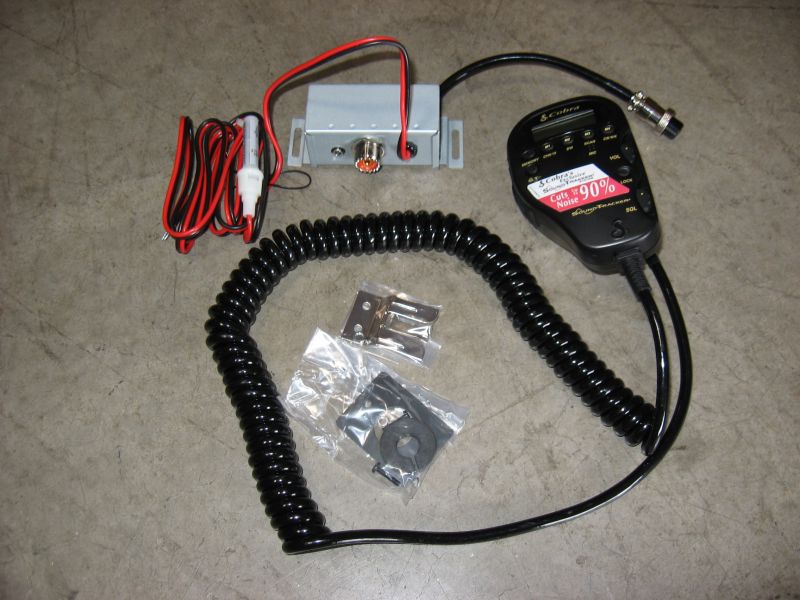
The Cobra 75 WX ST is a 40-channel CB that requires a very small footprint. The complete radio fits in your hand making it ideal for compact installations. It also provides you with 10 NOAA National Weather channels, full channel scan, dual watch, and an illuminated LCD display for easy viewing. This is an extremely popular radio with Jeep and off-road vehicle owners as it takes so little space and is much more convenient than mounting a traditional full-size CB in a small cab. The handset is connected to a small mounting/interface box that can be tucked under the seat or dash for a very clean installation.
The remote mounted interface box provides fused power, an antenna coax connection, a jack for an external speaker, and a connector for the handheld radio unit.

Bob was in charge of figuring out where he wanted to mount the interface box. After we checked the passenger seat for adequate clearance, we used a couple of self-tapping screws and located the interface box on the lower right front corner of the center console.

Power to the Cobra’s interface box was obtained from the unused Aux Power fuse socket in the fuse panel behind the glove box. On my ’98, that same Aux Power is provided by a labeled wire that is tucked back into the wiring harness behind the glove box.
I’m usually not one that is prone to tapping into a fuse box for power to run an auxiliary item such as a CB radio. However, this fuse socket was not in use (did not even have a fuse in it) and so Bob sprung for the fuse adapter at the local auto parts store. I crimped an insulated connector onto the of the adapter wire and put the corresponding connector on the positive (RED) power lead of the interface box. Needless to say it was a quick and easy way to get 12 volts for the radio.

I crimped a ring terminal onto the negative (BLACK) power lead of the interface box. The glove box is framed with a metal support which makes for a satisfactory power ground. After removing one of the mounting screws, I slipped the ring terminal over the hole and reinserted the screw. That wrapped up the power requirements for the Cobra radio.
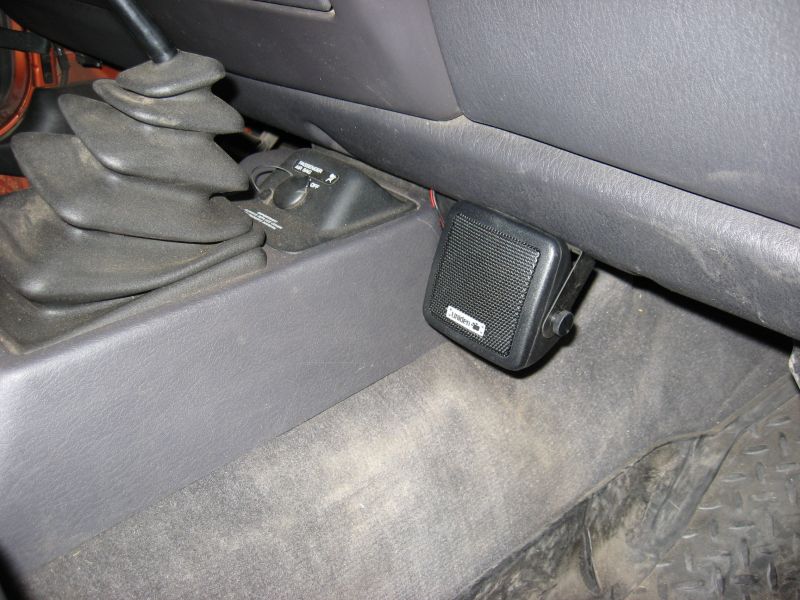
The remainder of the radio install consisted of drilling a small pair of holes for the external speaker’s mounting bracket. We were somewhat at a loss as to exactly where to put the speaker. This location will interfere a bit with tumbling the front seat fully forward. We needed to get the install wrapped up and Bob decided to use this spot for now and he would work on finding a more favorable location.
The power leads and speaker cable were both routed under the center console (passenger side) to keep them out of site and provide a degree of protection for them on their way back to the interface box. I used a short length of plastic wire conduit to cover the wires between the interface box and the console. Doing so provides another measure of protection and makes for a more professional looking installation, in my opinion.
With the speaker and interface box in place, Bob connected the radio to the connector on the interface box pigtail.
Wilson Flex-4 Antenna Adjustment
I’ve been running the Wilson 4′ model on my TJ now for a couple of years and have very pleased with the RF performance and its survivability factor on the trail. When I first spoke with Bob, he indicated he wanted to try the 4′ model and I passed that info along to the Right Channel Radio folks. You can view more of my comments regarding the Wilson Flex antenna.
With the radio mounted and the antenna installed, it was time to check the antenna SWR.
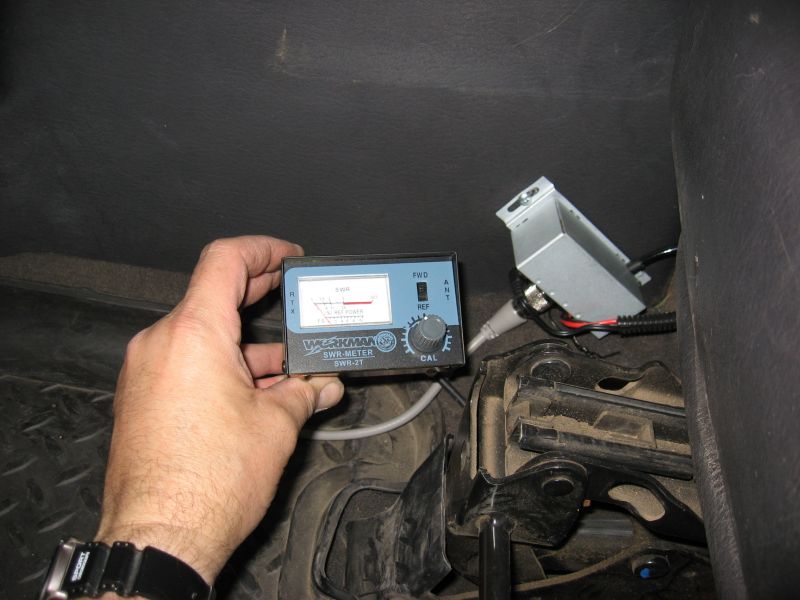
The SWR meter supplied with the Cobra Off-Road Kit is very easy to use. On the rear panel of the meter are two RF connectors. The front panel is marked to indicate which connector gets the antenna cable (you can seen ANT in the above photo) and which connector gets the short 12″ jumper attached to it and the remove interface box (as shown in the above photo.
The fundamentals of adjusting the antenna are pretty simple. The goal is to get as low of a SWR as you can. A ratio of 1 to 1 is perfect. 2:1 is not too bad and one can certainly live with that. 3:1 is the max and I would do some serious work to get mine lower than that if at all possible. Anything higher than 3:1 means you have problems that require attention and you shouldn’t use the radio.
Check your SWR at Channel 1 and then again at Channel 40. If the SWR is high on Channel 1 and low on Channel 40, then antenna is too short and you need to lengthen the adjustable tip.
If the SWR is high on Channel 40 and low on Channel 1, then antenna is too long and you need to shorten the adjustable tip.
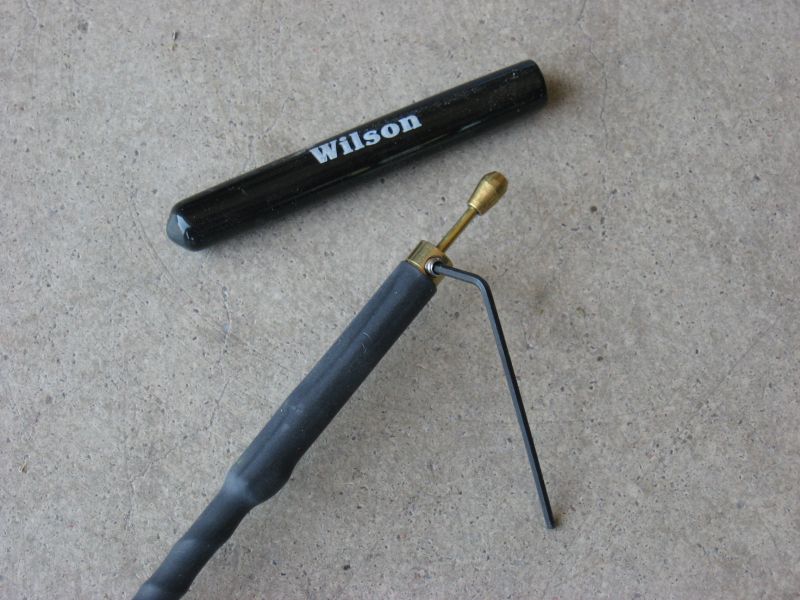
When adjusting the antenna tip, you should move it a very small amount, about 1/8″, and then check the SWR again. In most cases, a small amount of movement can change the SWR more than you might expect. Moving the tip in large increments may cause you to miss the “low spot” in the SWR curve leaving you with the appearance of something being wrong with your antenna.
To check the SWR, place the FWD/REF switch in the FWD (forward) position. Turn the channel control on the radio to the desired channel and push the push to talk (PTT) switch on the microphone. With the radio now in transmit mode, do not speak into the microphone. Keep the PTT switch pushed and adjust the CAL control on the front of the SWR meter such that the needle is aligned with the SET mark on the meter. With the PTT switch still pushed, change the switch to the REF (reflected) position and read your SWR on the top scale of the meter. A 1:1 SWR looks just as is shown in the above photo…..the red meter needle is resting on the “1” (far left end of the upper scale). A 3:1 SWR places the meter needle on the “3” mark at approximately the half scale position.
Every time you change the channel on the radio and check your SWR, be sure to place the switch in the FWD position and adjust the CAL control to the SET mark. Then move the switch to the REF position and read the SWR on the upper scale.
The SWR meter also indicates Percent of REFlected power. To read this, use the lower section of the upper scale. 25% reflected power is right at a 3:1 SWR.
Just a side note…..SWR meters are designed to work for a specific frequency range. This meter is accurate for those frequencies used by a CB radio. Use of the meter for other frequencies is not recommended as the accuracy is not guaranteed (or specified).
We adjusted the Flex-4 antenna on Bob’s TJ the best we could which ended up being about 2.5:1. That is not very good and as I cautioned Bob at the beginning of the installation, the mounting location placed too much of the antenna too close to the body of the TJ. I’ve seen this problem many times in the past on other vehicles and the only cure for it is the relocation of the antenna (as was also discussed). While poor SWR readings can be the fault of the antenna or coax, in this case it was not.
Cobra Off-Road CB Kit Performance Review
The Cobra 75 WX ST is quite an upgrade when compared to the Uniden 510XL radio. That is not to say the Uniden is not a good radio…..there is a marked difference in the cost of the two kits and the money spent for the Cobra nets you more radio.
Cobra uses a term called “Sound Tracker” technology that, as they say, “dramatically improves the quality of the transmission and reception of CB signals”. In a nutshell, the noise level is reduced in order to improve the signal-to-noise ratio and thus provide better overall reception. The user manual doesn’t actually state what in the transmitter is affected by the Sound Tracker technology.
The Cobra offers a function called Dual Watch. It allows you to monitor two CB channels at the same time. Channel 16 is automatically assigned as one of the channels and the user gets to select the 2nd channel. A feature like this is great on the trail as you can listen on the official “trail run channel” while you shoot the breeze with a friend or two on a different channel….all the time being able to respond to the “more important” announcements/comments that occur on the trail run channel. Ham radio operators have had this feature in their mobile FM radios for quite some time and it really is a nice feature. Congrats to Cobra for making it available in this radio.
The Cobra also provides coverage of all ten NOAA weather channels. These are VHF frequencies and you need to be within radio distance of a NOAA transmitter. If your wheeling area falls within the coverage area of a NOAA transmitter, you are in luck and can monitor the weather 24 hours a day.
An “Instant Channel 19” feature is also programmed into the radio. This allows you to immediately access Channel 19 with just a push of a the button. You don’t have to scroll through the channels with the up/down channel buttons in order to get there. Channel 19 is heavily used on the highways by the big truck drivers.
Last, but not least, you can tell the Cobra to scan all 40 of the channels. This works nicely if you are driving cross country and you are bored out of your mind and want to see if there is any activity on any of the CB channels. Again, it beats the heck out of manually checking each and every channel using the up/down channel buttons.
The LCD displays keep you pretty well informed of what the radio is doing. A reasonable signal strength meter display is available as are a handful of little indicators that tell you what the radio is doing (regarding the above various features).
The handheld unit (I hesitate to call it a microphone since it contains the entire radio) has the normal volume and squelch controls. You can also “lock” the keys to prevent your accidentally bumping one of them and turning something on or off at an inopportune time.
All in all the firmware features programmed into the Cobra 75 are quite impressive. If you are a gadget dude, you really do need to get your hands on one of these radios.
I’ll mention that you need to be a bit careful with the Cobra. As I mentioned, the entire radio is built into what would be the microphone housing on any other radio. As such, dropping the “mic” may have dire consequences. Don’t lay it up on the dash when you are done speaking, place it securely in the provided hanger. Doing so will certainly prevent it from dropping onto the floor (or out the door) when you take that corner a bit too fast.
How does it work?
As soon as we had power to the unit, Bob switched it over to 19 and we heard a conversation between two CBers. So yes, it seemed to do quite well with the vehicle parked in Bob’s warehouse. NOAA came through loud and clear as well (we have a pretty good NOAA transmitter here in the Phoenix area).
We’ve not had it on the trail yet but I see no reason it won’t perform much like the other Cobra 75 radios I’ve shared some trail time with. They usually have a good clear signal as long as their antenna system is properly adjusted and all the connections are tight.
Bob said he will give me some trail updates when he gets a chance to try it out. I’ll post them here when I get them so check back every now and then to see if new info has been added to this page.
Stop by and check out Right Channel Radio’s online CB Radio and Antenna Shop which carries a wide selection of radios, antennas and, of course, Jeep CB Kits. You’ll find this kit and other CB radios and accessories suitable for off-roading. Lot’s of good stuff for the Jeeper (and even those other brands too)!

